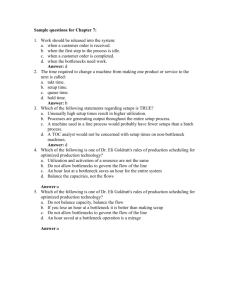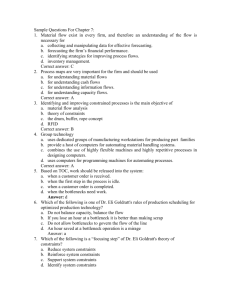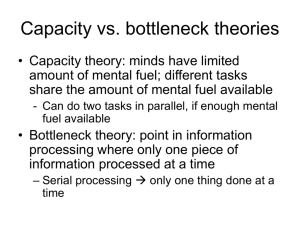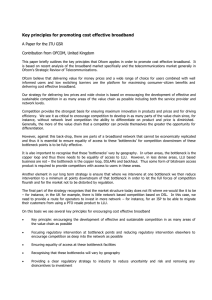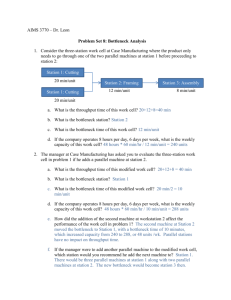Bibliography
advertisement
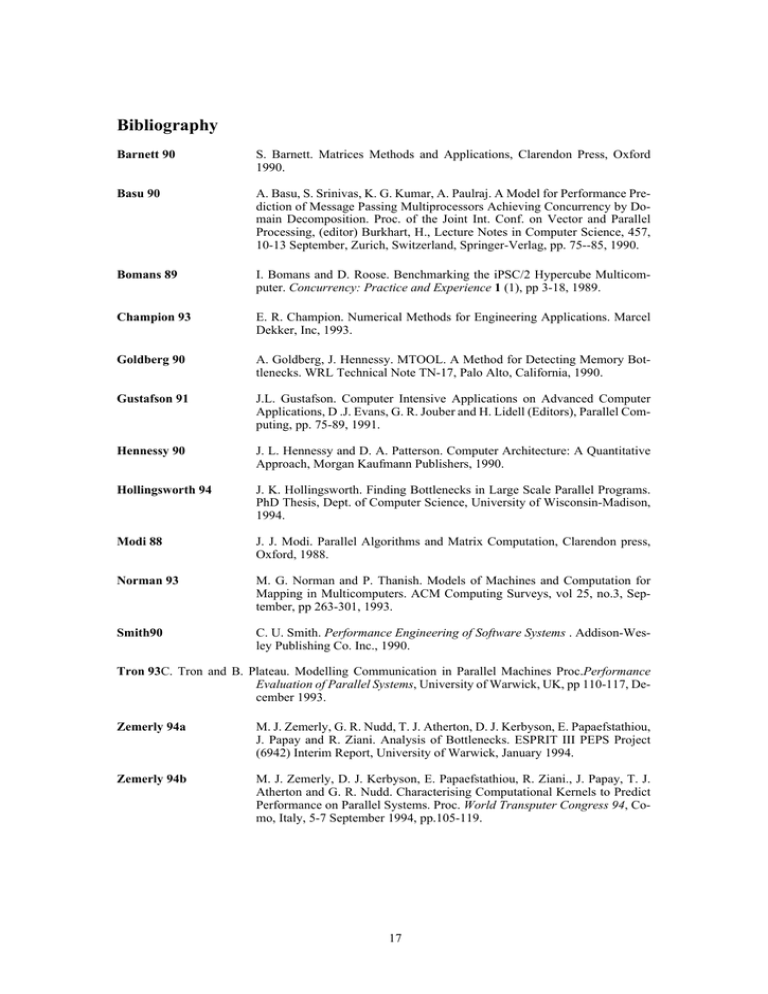
Bibliography
Barnett 90
S. Barnett. Matrices Methods and Applications, Clarendon Press, Oxford
1990.
Basu 90
A. Basu, S. Srinivas, K. G. Kumar, A. Paulraj. A Model for Performance Prediction of Message Passing Multiprocessors Achieving Concurrency by Domain Decomposition. Proc. of the Joint Int. Conf. on Vector and Parallel
Processing, (editor) Burkhart, H., Lecture Notes in Computer Science, 457,
10-13 September, Zurich, Switzerland, Springer-Verlag, pp. 75--85, 1990.
Bomans 89
I. Bomans and D. Roose. Benchmarking the iPSC/2 Hypercube Multicomputer. Concurrency: Practice and Experience 1 (1), pp 3-18, 1989.
Champion 93
E. R. Champion. Numerical Methods for Engineering Applications. Marcel
Dekker, Inc, 1993.
Goldberg 90
A. Goldberg, J. Hennessy. MTOOL. A Method for Detecting Memory Bottlenecks. WRL Technical Note TN-17, Palo Alto, California, 1990.
Gustafson 91
J.L. Gustafson. Computer Intensive Applications on Advanced Computer
Applications, D .J. Evans, G. R. Jouber and H. Lidell (Editors), Parallel Computing, pp. 75-89, 1991.
Hennessy 90
J. L. Hennessy and D. A. Patterson. Computer Architecture: A Quantitative
Approach, Morgan Kaufmann Publishers, 1990.
Hollingsworth 94
J. K. Hollingsworth. Finding Bottlenecks in Large Scale Parallel Programs.
PhD Thesis, Dept. of Computer Science, University of Wisconsin-Madison,
1994.
Modi 88
J. J. Modi. Parallel Algorithms and Matrix Computation, Clarendon press,
Oxford, 1988.
Norman 93
M. G. Norman and P. Thanish. Models of Machines and Computation for
Mapping in Multicomputers. ACM Computing Surveys, vol 25, no.3, September, pp 263-301, 1993.
Smith90
C. U. Smith. Performance Engineering of Software Systems . Addison-Wesley Publishing Co. Inc., 1990.
Tron 93C. Tron and B. Plateau. Modelling Communication in Parallel Machines Proc.Performance
Evaluation of Parallel Systems, University of Warwick, UK, pp 110-117, December 1993.
Zemerly 94a
M. J. Zemerly, G. R. Nudd, T. J. Atherton, D. J. Kerbyson, E. Papaefstathiou,
J. Papay and R. Ziani. Analysis of Bottlenecks. ESPRIT III PEPS Project
(6942) Interim Report, University of Warwick, January 1994.
Zemerly 94b
M. J. Zemerly, D. J. Kerbyson, E. Papaefstathiou, R. Ziani., J. Papay, T. J.
Atherton and G. R. Nudd. Characterising Computational Kernels to Predict
Performance on Parallel Systems. Proc. World Transputer Congress 94, Como, Italy, 5-7 September 1994, pp.105-119.
17
Figure 9. Breakdown of execution time components
Time (s)\Proc 1
2
4
8
16
32
64
128
Txp(256)
74.26
39.48
21.12
12
7.55
5.52
4.99
5.62
Tproc(256)
32.09
16.04
8.02
4.01
2
1
0.5
0.25
Tmem(256)
40.2
20.1
10.05
5.02
2.51
1.25
0.62
0.31
Ti/o(256)
1.97
1.97
1.97
1.97
1.97
1.97
1.97
1.97
Tcom(256)
0
0.37
0.58
0.75
0.94
1.23
1.86
3.07
Tfpu(256)
12.34
6.17
3.08
1.54
0.77
0.38
0.19
0.09
Tcpu(256)
19.75
9.87
4.93
2.46
1.23
0.61
0.3
0.15
Texm(256)
33.16
16.58
8.29
4.14
2.07
1.03
0.51
0.25
Tinm(256)
7.04
3.52
1.76
0.88
0.44
0.22
0.11
0.05
Tinp(256)
1.97
1.97
1.97
1.97
1.97
1.97
1.97
1.97
Tout(256)
0.006
0.006
0.006
0.006
0.006
0.006
0.006
0.006
Tcini
0
0.001
0.004
0.01
0.03
0.07
0.17
0.49
Tdist(256)
0
0.36
0.54
0.65
0.72
0.77
0.86
0.89
Tbroad(256)
0
0.005
0.02
0.06
0.16
0.37
0.79
1.65
Tcol(256)
0
0.01
0.01
0.01
0.02
0.02
0.02
0.03
Table 5. Breakdown of execution time components
Figure 9 shows clearly that Tinp becomes a major bottleneck starting from 32 processors
and for 128 processors Tbroad becomes another potential bottleneck.
5. Conclusions
A bottleneck analysis methodology for parallel systems based on characterisation has
been described. A characterisation method used here is based on the instruction level
analysis used in [Zemerly 94b]. A case study on a communication intensive algorithm
has been presented to illustrate and validate the bottleneck analysis methodology. The
execution time measurements obtained from running a parallelised version of the linear
solver on the target machine were compared with the predictions and showed an average error of about 15%. Three bottleneck metrics were successfully used in the analysis
to identify the execution time components causing the bottlenecks. The analysis identified a bottleneck problem in the algorithm and a part of the code causing the bottleneck was optimised resulting in a significant performance improvement.
16
6
mem/proc
5
comms/comp
4
3
2
1
0
1
2
4
8
16
32
64
128
Processors
Figure 8. Communication-computation and memory-processing ratios for 256 equations
As can be seen from Figure 7 the communication becomes a bottleneck after 64 processors while the I/O time is a bottleneck between 16 and 64 processors. Figure 8 shows
that the communication-computation ratio exceeds unity at around 48 processors and
hence the communication is becoming a potential bottleneck after that number. The
memory-processing ratio is constant throughout because of the absence of a cache
memory level on the Parsytec system. This ratio will show clearly the effect of cache
in systems where it exists. Figure 9 and Table 5 show the breakdown of execution time
components for various number of processors for 256 equations.
Tcoll(256)
100%
Tbroad(256)
80%
Tdist(256)
Tcini(256)
Time, %
60%
Tout(256)
Tinp(256)
40%
Tinmem(256)
Texmem(256)
20%
Tcpu(256)
Tfpu(256)
0%
1
2
4
8
16
32
Processors
15
64 128
100%
80%
Tcom(256)
Time, %
60%
Ti/o(256)
40%
Tmem(256)
Tproc(256)
20%
0%
1
2
4
8
16
32
64
128
Processors
Figure 6. Processing, memory, communication and I/O percentages
Figures 7 and 8 show the B-ratio and the communication-computation ratio for 256
equations for various numbers of processors.
Bproc
1.2
Bmem
1
Bcomm
Bi/o
B-ratio
0.8
0.6
0.4
0.2
0
1
2
4
8
16
32
64
128
Processors
Figure 7. B-ratio for processing, memory, communication and I/O for 256 equations
14
(15)
Tbroad =
∑Τ
χοµ
νειγηβουρσ
(λι ,1)
As can be seen from the results above the introduction of optimised broadcast subroutine provided good scalability for the algorithm.
4.3. Results of the bottleneck analysis for the optimised code
The results in Figures 5, 6 show the components of the execution time: processing,
memory, communication and I/O for 256 linear equations for various number of processors.
Time, s
80
70
60
Tcom(256)
50
40
Tmem(256)
Ti/o(256)
Tproc(256)
30
20
10
0
1
2
4
8
16
32
64
128
Processors
Figure 5. Processing, memory, communication and I/O times
13
Note that the broadcast used here is based on a simple one-to-all communication. A detailed analysis of the results identified a bottleneck in the communication component
which is represented by the broadcast subroutine. This subroutine was then optimised
using neighbourhood communication. A sample of the bottleneck analysis which was
carried out on the non-optimised code will be given for the final version of the code instead. Figure 4 and Table 4 show the execution time measurements and predictions for
the optimised linear solver.
700
measured_opt(128)
600
measured_opt (256)
500
measured_opt (512)
predicted_opt (128)
Time, s
400
predicted_opt (256)
predicted_opt (512)
300
200
100
0
1
2
4
8
16
32
64
128
Processors
Figure 4. Execution time prediction and measurements of the optimised linear solver
1
2
4
8
16
32
64
128
measured_opt(128)
10.13
5.63
3.36
2.31
1.82
1.72
1.85
2.34
measured_opt (256)
78.15
41.33
22.67
13.73
9.4
7.46
6.89
7.54
measured_opt (512)
612.26
316.85
166.41
92.35
55.21
38.22
30.5
29.3
predicted_opt (128)
9.51
5.35
3.03
1.9
1.4
1.26
1.47
2.16
predicted_opt (256)
74.26
39.48
21.12
12
7.55
5.52
4.99
5.62
predicted_opt (512)
586.52
302.79
156.83
83.99
47.79
30.06
22.13
19.69
Table 4. Predictions and measurements for the optimised linear solver
The broadcast time used here can be given by:
12
(14)
π
Tbroad = ∑ Τχοµ (λι ,δ σενδερ,ι ) ωηερει ≠ σενδερ
ι=0
The value of li for distribution is (N/p)*(N+1)*8, for collection is (N/p)*8 and for broadcasting is (N+1)*8. The parameter di,j is the distance between processors i and j. The
linear solver algorithm was implemented on the Parsytec machine and the execution
times were measured to validate the predictions. The results of the predictions and the
measurements for various task sizes (128, 256 and 512 equations) and number of processors are given in Figure 3 and Table 3.
700
measured_nopt(128)
measured_nopt (256)
600
measured_nopt (512)
500
predicted_nopt (128)
predicted_nopt (256)
Time, s
400
predicted_nopt (512)
300
200
100
0
1
2
4
8
16
32
64
128
Processors
Figure 3. Predictions and measurements for the non-optimised linear solver
1
2
4
8
16
32
64
128
measured_nopt(128)
10.13
5.65
4.05
3.4
4.47
8.73
17.33
36.56
measured_nopt (256)
78.21
41.52
27.21
18.91
20.91
36.03
69.81
146.27
measured_nopt (512)
612.35
317.93
198.06
116.48
104.07
156.49
283.32
622.91
predicted_nopt (128)
9.51
5.48
3.5
3.24
4.49
9.11
19.53
44.89
predicted_nopt (256)
74.26
39.98
23
17.32
19.75
36.12
73.41
160.9
predicted_nopt (512)
586.52
304.78
164.32
105.24
96.4
151.62
291.77
624.61
Table 3. Predictions and measurements for non-optimised linear solver
11
broadcasting the k-th row to all the processors and updating the submatrix on all the
processors.
The parallel linear solver can be obtained by extending the sequential algorithm with
communication routines which provide distribution of input data, broadcasting and collection of output data during the algorithm execution. The block-row data decomposition which divides the matrix horizontally and assigns adjacent blocks of rows to
neighbouring processors is considered here. The matrix decomposition and the communication graph for four processors are presented in Figure 2.
p1
p2
p3
p4
P0
P1
P2
P3
1
2
P0
P1
P2
P3
3
4
5
6
P0
P1
P2
P3
•
•
•
7
8
P0
P1
P2
P3
P0
P1
P2
P3
Figure 2. Block row data decomposition and the communication graph
Assuming that Ts and Tpo are negligible and Up is 1 in equation (7), the parallel execution time for the linear solver can be given by:
(11)
T xp (N, p) =
Τξ (Ν)
+ Τδιστ + Ν × Τβροαδ + Τχολλ+ ΤΙ/ Ο
π
where
(12)
π
Tdist = ∑ Τχοµ(λι ,δ0,ι )
ι=1
(13)
π
Tcoll = ∑ Τχοµ (λι ,δ0,ι )
ι=1
10
i=0,N
Inv
j=i+1,N
Norm
k=0,N-1
Set
j=i+1,N
Rsub
i=0,N
Buf
Figure 1. Software execution graph for the sequential linear solver
The computational blocks shown in Figure 1 are:Inv- calculate the inverse of the pivot
element, Norm- normalisation of the actual row, Set- variable setting, Rsub- row subtraction and Buf- data buffering.
The sequential execution time for the linear solver can be given by:
(10)
Ν
Ν
Ν−1
Ν
Ν
T x (N) = ∑ τΙνϖ + ∑ τΝορµ + ∑ τΣετ + ∑ τΡσυβ + ∑ τΒυφ
ι=1
ι= 0
ϕ=ι+1
κ=0
ϕ=ι+1
where ti is the number of cycles for module i.
4. 2. Parallel linear solver
The diagonalisation of the initial matrix requires N algorithmic steps (k =1,N) and each
step consists of the sequence of the following operations: normalisation of the k-th row,
9
perCluster is described to illustrate the use and validate the bottleneck analysis methodology. Linear solvers belong to the computational and communication intensive
class of algorithms. A system of linear equations can be represented in the following
form:
AX=B
(9)
where A is a non-singular square matrix, B is the solution vector and X is a vector of
unknowns. There are several solution methods for the system of linear equations which
can be classified as direct and iterative methods. In the case of direct methods the
amount of computation required can be specified in advance, whereas for the iterative
methods the number of computation steps depends on the value of the initial solution
vector and the required precision. Typical examples of the direct methods are Gauss
elimination with back substitution, Gauss-Jordan elimination, LU, QR and Cholesky
factorisations [Barnett 90, Modi 88]. The iterative methods are based on Jacobi or
Gauss-Seidel algorithms [Champion 93].
For this case study the Gauss-Jordan elimination has been selected since this algorithm
provides a good load balance during the parallel computation. The operations involved
in Gauss-Jordan elimination are very similar to that of the well known Gauss elimination, but instead of calculating an upper-triangular matrix followed by back substitution, the algorithm immediately calculates a diagonalised matrix, e.g. instead of just
subtracting the normalised actual row of the matrix from the rows below them at each
stage, the subtraction is performed for all other rows in the matrix. The sequential complexity of the algorithm is O(N3). The software execution graph for the sequential linear solver based on the Gauss-Jordan elimination algorithm is shown in Figure 1.
8
(8)
∑ πι × Τι
Up = ι
π∑ Τι
ι
where pi is the number of processors active at stage i and Ti is its execution time.
3.5. Bottleneck analysis
A prediction of the components constituting the execution time to identify the slowest
part of the system is first carried out using the characterisation method described before. Also three metrics are used to identify bottlenecks in the system, these are the Bratio, the communication to computation ratio and memory to processing ratio. The Bratio (B stands for bottleneck) of an execution time component (i.e. processing, memory, communication and I/O) is the ratio of the component to the sum of all other components. This metric is dimensionless and a simple comparison between all the B-ratios
will clearly identify a bottleneck problem when visualised in the same plot. The best
performance is obtained when all the B-ratios are equally balanced and have values less
than unity. The communication to computation and memory to processing ratios can be
used to identify the communication and memory bottlenecks, i.e. when they exceed unity. These ratios will be used for the bottleneck analysis of the linear solver presented in
section 4. Once an execution time component is identified as a bottleneck further analysis of its sub-components can be carried out to highlight any software or hardware related problems causing the bottleneck. This will allow optimisation of software or
usage of the hardware resources where possible. These sub-components are: FPU,
CPU, external memory, internal memory, initialisation of communication links, data
distribution, data collection, other communication overheads, disk read time and disk
write time.
4. Bottleneck analysis of large dense systems of linear equations
4.1. Description of the linear solver
In this section the solution of large dense systems of linear equations on a Parsytec Su7
The cost of I/O can be analytically expressed by the following formulas (5, 6):
(5)
Tinput (l) = α ρεαδ + β ρεαδλ
(6)
Toutput (l) = α ωριτε + β ωριτελ
The coefficients of the formulas above can be obtained by fitting a linear model to measurements provided on the target machine. For the Parsytec machine these coefficients
are =642.16, =3.73, =1583.73 and =2.2.
α ρεαδ
β ρεαδ
α ωριτε
β ωριτε
3.4. Parallel execution time
The parallel execution time can be derived from the sequential execution time using the
non-overlapped computation-communication model for parallel algorithms [Basu 90,
Zemerly 94b] and is given by:
(7)
T xp (N, p) = Τσ +
Τπ
+ Τ πο + Ττχοµ + ΤΙ / Ο
Υπ × π
where Tp is the execution time of the algorithm part that can be parallelised. Ts is the
execution time of the serial part of the algorithm including initialisation time. Tpo is the
parallel overhead processing required when parallelising an algorithm, it can only be
used when the overhead is known a priori. For example, processing of the data overlap
that may be necessary between processors for a domain decomposition problem. Ttcom
is the total communication overhead, TI/O is the input/output times and Up is the processor utilisation and is given by:
6
The total communication cost can be given by:
(3)
Ttcom = Τινιτ + Τδιστ + Τχολλ+
σταγεσ
∑Τ
ι
χοµ
(λι ,δι , πι )
where Tinit is the initialisation of the communication links (on the Parsytec each link
requires 1270 s), Tdist is the data distribution time, Tcoll is the collection time and Tcom
is the communication time required in individual stages of the algorithm.
The time of the point-to-point communication depends on the message length (l) and
the distance (d) the message has to travel (the number of hops). An analytical communication model for quiet networks is described by Tron [Tron 93]. In this paper a simpler communication model based on the work of Bomans [Bomans 89] and Norman
[Norman 93] is used and given by:
(4)
α 1 + β 1λ+ γ 1δ + δ1λδ λ≤ πσ
Tcom (l,d) =
α 2 + β 2 λ+ γ 2 δ + δ 2λδ λ> πσ
For the Parsytec SuperCluster, the target machine used in this paper, the packet size, ps,
is assumed equal to 120 bytes, and the parameters for equation (4) obtained by least
square fitting of measured communication times are given in Table 2.
l ≤ πσ
α
β
γ
δ
51.1
0.27
8.86
0.68
-81.5
1.33
93.04
0.05
l f ps
Table 2. Parameters of the quiet network communication model of the Parsytec SuperCluster
Tdist and Tcoll are functions of Tcom and will be described later for the case study.
3.3. The I/O component
5
external), communication (initialisation, distribution, collection etc.) and I/O (disk
read/write). These components can be further analysed and potential bottleneck problems can be identified as will be shown later.
3.1. The computation and the memory components
The instruction level characterisation method described in [Zemerly 94b] is used here
to predict the performance of the system. The computation component time can be given by:
(1)
Tcomp = τ0 + (νεξ + νµεµ ) × τχψχ
For the Parsytec system studied here equation (1) becomes:
(2)
Tcomp = (νχπυ + ν φπυ − νφπυ_ οϖερ+ ν
4 4 +4 ν2εξτµεµ
4 4+ 4ν3ινστ) × τχψχ
1 4 44 2 4 4 43 1ιντµεµ
νµεµ
νεξ
where
t0
start-up time for vector processors
nex
total number of cycles to execute the instructions
nmem
total number of memory cycles
nintmem additional time spent to access internal memory
nexmem additional time spent to access external memory
ninst
total number of cycles required to fetch instructions from ex-
ternal memory
ncpu
total number of CPU cycles
nfpu
total number of FPU cycles
nfpu_over total number of FPU cycles overlapping the CPU
tcyc
processor cycle time
3.2. The communication component
4
slow system component affects the performance of the whole system by preventing other components from running at full speed. So it is important to identify these slow components (software or hardware) and reduce their effects in order to achieve optimal
performance.
Gustafson in his paper [Gustafson 91] argues that almost every computer is limited not
by the speed of the arithmetic unit but the memory bandwidth and latency. Using several examples the author showed that this problem is becoming visible even for workstations not just for parallel computers. Gustafson introduced the idea of characterising
the system performance not by the Mflop rate but by the number of delivered Mword/s.
Amdahl described the balanced computing system as a system which for each Mflop/s
arithmetic performance can deliver 1Mword/s. Amdahl's law states that the performance enhancement with a given improvement is limited by the amount that the improved feature is used [Hennessy 90].
Hollingsworth [Hollingsworth 94] in his thesis describes a monitoring based bottleneck
analysis methodology using an iterative process of refining the answers to three questions concerning performance problems. These three questions are: why is the application performing poorly, where is the bottleneck, when does the problem occur. The why
answer identifies the type of bottleneck (e.g. communication, I/O etc.). The where answer isolates a performance bottleneck to a specific resource used by the program (e.g.
disk, memory etc.). Answering the when question isolates a specific phase of the program execution.
Goldberg and Hennessy [Goldberg 90] described a simple monitoring method for detecting regions in a program where the memory hierarchy is performing poorly by observing where the actual measured execution time differs from the time predicted given
a perfect memory system.
Bottleneck analysis based on instruction code level characterisation has been described
by Zemerly [Zemerly 94a]. This approach investigates where the time is spent during
the program run. The analysis concentrates on the following components: memory (internal, external), processor (ALU, FPU), communication and I/O.
3. Methodology of Bottleneck Analysis
The instruction level bottleneck analysis is based on identification of the following
components of the total execution time: computation (ALU, FPU), memory (internal,
3
In this paper the second definition is used as the basis for the bottleneck analysis methodology which involves the following steps: predict the execution time components of
a certain workload, identify the time component responsible for the bottleneck (the
slowest part), analyse the component causing the bottleneck into its constituent and
identify the sub-components causing the problem. Optimisation of the software subroutines and/or hardware utilisation causing the bottleneck can improve the system performance. This operation can be iterated until no further optimisation is possible. Potential
sources of bottlenecks are summarised in Table 1.
Processing
Memory
Communications
I/O
System parameters
Workload parameters
CPU
integer operations
FPU
fp operations
internal
internal memory accesses
cache
cache hits
external
external memory accesses
latency
distance
bandwidth
message size
topology
communication pattern
number of processors
synchronisation
disk (access time, bandw.) disk operations
terminal
terminal operations
Table 1. Sources of potential bottlenecks
In section 2 a background to the bottleneck analysis is given. Section 3 introduces a bottleneck analysis methodology based on instruction level analysis. Section 4 provides a
case study to illustrate and validate the proposed bottleneck analysis methodology. The
case study selected is a communication intensive linear solver algorithm (Gauss-Jordan
elimination) which was implemented on a transputer-based mesh connected distributed
memory parallel computer (128 T800 Parsytec SuperCluster).
2. Background
A bottleneck in a system is usually the main reason for its performance degradation. A
2
Characterisation Based Bottleneck Analysis of Parallel Systems
M.J. Zemerly, J. Papay, G.R. Nudd
Parallel Systems Group, Department of Computer Science,
University of Warwick, Coventry, UK
Email: {jamal, yuri, grn}@dcs.warwick.ac.uk
Abstract
Bottleneck analysis plays an important role in the early design of parallel computers
and programs. In this paper a methodology for bottleneck analysis based on an instruction level characterisation technique is presented. The methodology is based on the assumption that a bottleneck is caused by the slowest component of a computing system.
These components are: memory (internal, external), processor (ALU, FPU), communication and I/O. Three metrics were used to identify bottlenecks in the system components. These are the B-ratio, the communication-computation ratio and the memoryprocessing ratio. These ratios are dimensionless with values greater than unity indicates
the presence of a bottleneck. The methodology is illustrated and validated using a communication intensive linear solver algorithm (Gauss-Jordan elimination) which was implemented on a mesh connected distributed memory parallel computer (128 T800
Parsytec SuperCluster).
1. Introduction
One of the main concerns of parallel computing is to port sequential programs efficiently knowing the resource limitations of the target machine such as processor, memory
and communication network. In order to improve the performance of the parallel code
bottleneck analysis is required. The identification of bottlenecks within parallel systems is an important aspect of hardware and software design. This process involves examining the system behaviour under various load conditions. Bottlenecks can be
defined in several ways as:
• The parts of the program that prevent achieving the optimal execution time.
• The parts of the system either hardware or software which consumes the maximum
time or the slowest component of the system.
1


